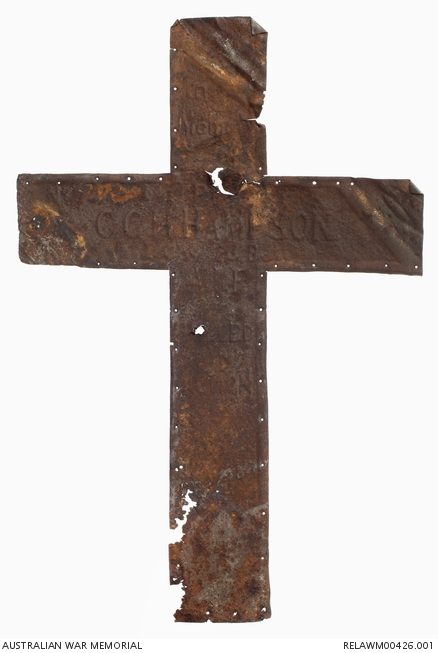| Place | Middle East: Ottoman Empire, Turkey, Dardanelles, Gallipoli, Anzac Area (Gallipoli), Lone Pine Area, Brown's Dip |
|---|---|
| Accession Number | RELAWM00426.001 |
| Collection type | Heraldry |
| Object type | Heraldry |
| Physical description | Tin |
| Maker |
Linklater, Thomas Murray Unknown |
| Place made | Ottoman Empire: Turkey, Dardanelles, Gallipoli |
| Date made | October 1915 |
| Conflict |
First World War, 1914-1918 |
Grave cross made from a biscuit tin : Private C G H Hampson, 23 Battalion AIF

Cross shaped metal plate, made from a biscuit tin. The inscription is recorded in raised detail and reads: 'In / memory / of / No.743 P[te] C G H HAMPSON / D Coy 23 Batt / AIF / KILLED / IN / ACTION / [date illegible]'. The plate has a dark brown patina of (inert) rust and has two bullet holes in it. There are small holes around the edge of the plate through where nails once attached it to a wooden cross. The top of the cross, and the two arms, have multiple ridges, possibly caused by the removal of the plate its wooden cross after the war.
This plate from a grave cross made for Private Charles Hampson, and another for Corporal David McVay (RELAWM00426.002), was recovered at Gallipoli by Captain Gordon Samuel Keesing in 1919. Keesing was an assistant to Sir John Burnet, the architect tasked with the design of the permanent cemeteries at Gallipoli. Originally the plate was attached to a wooden cross, but this was probably used as fire wood by Turkish soldiers or civilians after the evacuation, as wood was a scarce commodity in the area. The plate was removed from the cross and left lying over his grave.
743 Private Charles George Hubbard Hampson was a 36 year old driver from Richmond, Victoria when he enlisted in the AIF on 1 March 1915. He embarked from Melbourne with D Company, 23 Battalion aboard HMAT Euripides on 10 May.
After a period of training in Egypt, Hampson landed with 23 Battalion at Gallipoli on the night of 4 September and was marched to Rest Gully. On 5 September the battalion spent their first night in the front line trenches at Lone Pine. The fighting here was so dangerous and exhausting that battalions were relieved every day. The 23rd Battalion manned Lone Pine, alternating with the 24th Battalion, until they left Gallipoli in December 1915.
Hampson was killed on 3 October 1915, at Lone Pine. That day, Turkish artillery were firing from the direction of Scrubby Knoll at the Lone Pine trenches, and he was killed by a shell. Hampson was originally buried at the nearby Brown's Dip Cemetery. After the war this cemetery was found to be at risk from erosion, so in 1923 the bodies there were exhumed and reinterred in what became known as the Brown's Dip plot in Lone Pine Cemetery.
Hampson's and McVay's crosses were made by members of the 23 Battalion. In 1923 one of the makers, Thomas Linklater, a former member of the 23rd Battalion, contacted the Memorial after seeing the crosses on display in Melbourne. In his letter, Linklater noted that '…The crosses referred to are in themselves only trivial things but the conditions under which they were made make them more valuable. When you remember that wood was more valuable to us than money for heating & cooking purposes the wood from which those two crosses were made was worth a fortune. The wood was saved from a case we managed to get hold of also the nails with which it was fixed. Next we saved a biscuit tin from the rubbish & nailed this on the wooden cross with brass sprigs borrowed from the bootmaker. We then drew out the lettering in pencil finally stamping out the design with a punch borrowed from the bootmaker…'.